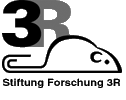
Felix Grimm
Institute of Parasitology, University of Zürich, 8057 Zürich, Switzerland
felix.grimm@access.uzh.ch
Keywords: pharmacology; toxicology; reduction; toxicity testing: pharmaceuticals
Duration: 2 years Project Completion: 1999
Background and Aim
Leishmaniasis is one of the major parasitic diseases in many tropical and subtropical countries. A safe and effective vaccine is not yet available. Some of the commonly used drugs have been known to cause severe adverse side effects; treatment failure is also common. The development of new effective drugs and reliable test procedures is therefore an urgent task.
The promastigote insect stages of leishmania parasites can easily be cultivated in vitro. These forms are used for drug testing although they do not reflect the situation in the host. Test systems which rely on the 'correct' vertebrate (amastigote) stage of the parasite require either in vivo infection experiments using laboratory animals or time consuming co-cultivation of the parasite with macrophages or macrophage-like cells in vitro. The present project had three goals: 1. Establishment of axenic amastigote cell lines of different Leishmania species in vitro. 2. Replacement of fetal bovine serum (FCS) in culture media and 3. Evaluation of axenically grown amastigotes as a screening system for leishmanicidal substances.
Method and Results
Ten Leishmania isolates (L. infantum: 6 isolates, L. donovani, L. tropica, L. major, L. aethiopica: one isolate each) have been successfully adapted to grow as axenic amastigote or amastigote-like forms. Promastigote forms were propagated in vitro (27oC, pH 7.2) in a defined liquid medium requiring no serum or serum substitutes at. Amastigotes forms were cultivated in a slightly modified medium [1] substituted with 1% of a commercially available serum fraction produced from abundantly available adult bovine serum (FC III, HyClone) which obviates the need for fetal bovine serum. Axenic amastigotes were produced from promastigotes by increasing the temperature stepwise to 36oC followed by decreasing the pH of the medium stepwise to 5.4 [2].
Drug sensitivities of log phase axenic Leishmania infantum (isolate 229/1/89, zymodeme MON1) promastigotes were then compared with those of the clinically relevant amastigote stage: the incorporation of [3H]-thymidine in the presence of different concentrations of anti-leishmanial drugs was measured and the corresponding IC50 calculated. Three clinically important antileishmanial drugs (allopurinol, Glucantime®, ketoconazole) and a series of dinitroanilines [3] were tested in this system. Whereas promastigotes were completely unresponsive to one of the main antileishmanial drugs, Glucantime®, amastigote forms showed a promising sensitivity
(see also 3R-INFO-BULLETIN Nr. 12).
Conclusions and Relevance for 3R
Amastigote forms are the more appropriate target. The finding that IC50 values obtained with axenic amastigotes are comparable to values obtained in intracellular systems shows that axenic amastigotes might have the potential to replace intracellular systems or animal models at defined stages during drug development. Furthermore, the possibility of producing large quantities of the clinical relevant amastigote stage in vitro allows detailed studies on the mode of action of antileishmanial drugs to be carried out, which in turn will promote the rational design of new leishmanicidal compounds.
References
1. Grimm F., Brun R., Jenni L. (1991): Promastigote infectivity in Leishmania infantum. Parasitol.Res. 77, 185-191.
2. Eperon S. and McMahon-Pratt D. (1989): I. Extracellular cultivation and morphological characterization of amastigote-like forms of Leishmania panamensis and L.braziliensis. J. Protozool. 36, 502-510.
3. Armson A., Kamau S.W., Grimm F., Reynoldson J.A., Best W.M., MacDonald L.M., Thompson R.C.A. (1999): A comparison of the effects of a benzimidazole and the dinitroanilines against Leishmania infantum. Acta Tropica 73, 303-311.
4. Grimm F. (2002) Replacement of fetal bovine serum for the maintenance of axenic amastigote forms of Leishmania infantum )in preparation).